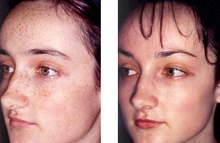
Chemical peel is a skin-resurfacing procedure that involves application of a chemical solution to the damaged facial areas. The procedure is meant to peel away the superficial layers of the skin (exfoliation) giving a youthful, unblemished complexion.
Chemical peels rejuvenate the skin’s texture and appearance by improving the scars, discoloration, wrinkles, and sun damage.
Chemical peels can be done alone or as a companion treatment for other cosmetic procedures.
Chemical peels vary according to their specific ingredients and their strength. The peeling action depends on the duration the solution remains on the skin and the depth of application. Superficial/light, medium, or deep are the various depths at which the solution can be applied to achieve the desired appearance.
The superficial or light peel solution is composed of alphahydroxy acids (AHAs) such as glycolic, lactic, and salicylic or fruit acids.
Medium depth peels uses trichloroacetic acid (TCA), which remains on the skin for a longer time than the light peel.
Deep facial peels are typically performed with phenol-based solutions.
You will be prescribed a soothing agent, such as petroleum jelly to apply over the red, dry, and mildly irritated areas of skin. Medium and deep facial peels result in severe redness and swelling. Apply ice packs wrapped in a towel over the treated areas to minimize swelling. Medications such as NSAIDs will be prescribed to alleviate pain and keep you comfortable. Apply moisturizer to keep your skin moist and supple. Use sunscreen to protect your skin from the damaging effects of sun.
Healing time varies from 3-14 days depending on the type of peel you have undergone. You will probably need several sessions to achieve the maximum result.
A follow-up appointment should be scheduled 2-3 days after treatment to examine your progress.
Professional chemical peel treatments accelerate the skins natural exfoliation process providing you with fresher, revitalized skin. Depending on the strength of your chemical facial peel, flaking may be experienced but there is no down time and make up can be worn shortly after. You will need approximately 4 to 6 treatments depending on the severity of your skin concerns. Your specialist will advise you on the appropriate skincare regime if required and active ingredients to avoid for 5 days after treatment.
Chemical peels are usually done as an outpatient procedure. The first step involves thorough cleansing of your face. Your surgeon will select the solution that best suits for the treatment of your damaged skin. A deep chemical peel may require sedation (local anesthesia) to numb the areas of treatment.
Using a cotton pad or a brush, the chemical is applied to the areas to be treated. While the chemical remains on the skin, you might feel a burning or stinging sensation for a few minutes. Cool saline compresses will be used to ease the sensation. A deep peel wound requires a surgical dressing.
GET IN TOUCH